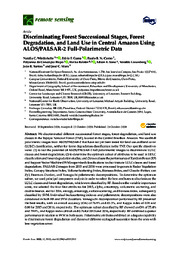Discriminating Forest Successional Stages, Forest Degradation, and Land Use in Central Amazon Using ALOS/PALSAR-2 Full-Polarimetric Data.
Discriminating Forest Successional Stages, Forest Degradation, and Land Use in Central Amazon Using ALOS/PALSAR-2 Full-Polarimetric Data.
Autoria: WIEDERKEHR, N. C.; GAMA, F. F.; CASTRO, P. B. N.; BISPO, P. da C.; BALZTER, H.; SANO, E. E.; SANTOS, J. R.; LIESENBERG, V.; MURA, J. C.
Resumo: We discriminated different successional forest stages, forest degradation, and land use classes in the Tapajós National Forest (TNF), located in the Central Brazilian Amazon. We used full polarimetric images from ALOS/PALSAR-2 that have not yet been tested for land use and land cover (LULC) classification, neither for forest degradation classification in the TNF. Our specific objectives were: (1) to test the potential of ALOS/PALSAR-2 full polarimetric images to discriminate LULC classes and forest degradation; (2) to determine the optimum subset of attributes to be used in LULC classification and forest degradation studies; and (3) to evaluate the performance of Random Forest (RF) and Support Vector Machine (SVM) supervised classifications to discriminate LULC classes and forest degradation. PALSAR-2 images from 2015 and 2016 were processed to generate Radar Vegetation Index, Canopy Structure Index, Volume Scattering Index, Biomass Index, and Cloude?Pottier, van Zyl, Freeman?Durden, and Yamaguchi polarimetric decompositions. To determine the optimum subset, we used principal component analysis in order to select the best attributes to discriminate the LULC classes and forest degradation, which were classified by RF. Based on the variable importance score, we selected the four first attributes for 2015, alpha, anisotropy, volumetric scattering, and double-bounce, and for 2016, entropy, anisotropy, surface scattering, and biomass index, subsequently classified by SVM. Individual backscattering indexes and polarimetric decompositions were also considered in both RF and SVM classifiers. Yamaguchi decomposition performed by RF presented the best results, with an overall accuracy (OA) of 76.9% and 83.3%, and Kappa index of 0.70 and 0.80 for 2015 and 2016, respectively. The optimum subset classified by RF showed an OA of 75.4% and 79.9%, and Kappa index of 0.68 and 0.76 for 2015 and 2016, respectively. RF exhibited superior performance in relation to SVM in both years. Polarimetric attributes exhibited an adequate capability to discriminate forest degradation and classes of different ecological succession from the ones with less vegetation cover.
Ano de publicação: 2020
Tipo de publicação: Artigo de periódico
Unidade: Embrapa Cerrados
Palavras-chave: Amazonia, Degradação Ambiental, Floresta, Uso da Terra
Observações
1 - Por padrão são exibidas publicações dos últimos 20 anos. Para encontrar publicações mais antigas, configure o filtro ano de publicação, colocando o ano a partir do qual você deseja encontrar publicações. O filtro está na coluna da esquerda na busca acima.
2 - Para ler algumas publicações da Embrapa (apenas as que estão em formato ePub), é necessário ter, no celular ou computador, um desses softwares gratuitos. Sistemas Android: Google Play Livros; IOS: iBooks; Windows e Linux: software Calibre.
Acesse outras publicações
Acesse a Base de Dados da Pesquisa Agropecuária (BDPA) para consultar o acervo completo das bibliotecas da Embrapa.

